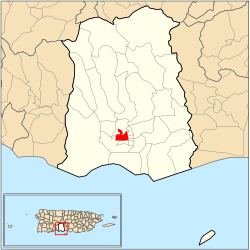Segundo | |
|---|---|
 A street in Barrio Segundo at dusk, in the Ponce Historic Zone | |
 Location of barrio Segundo within the municipality of Ponce shown in red | |
| Coordinates: 18°00′52″N66°37′15″W / 18.014444°N 66.620809°W [1] | |
| Commonwealth | |
| Municipality | |
| Area | |
• Total | 0.53 sq mi (1.4 km2) |
| • Land | 0.53 sq mi (1.4 km2) |
| • Water | 0 sq mi (0 km2) |
| Elevation | 85 ft (26 m) |
| Population (2010) | |
• Total | 7,213 |
| • Density | 13,609.4/sq mi (5,254.6/km2) |
| Source: 2010 Census | |
| Time zone | UTC−4 (AST) |
Segundo (Barrio Segundo) is one of the 31 barrios of the municipality of Ponce, Puerto Rico. Along with Primero, Tercero, Cuarto, Quinto, and Sexto, Segundo is one of the municipality's six core urban barrios. It was organized in 1878. [3] Barrio Segundo has 3 subbarrios: Baldority de Castro (or just "Baldorioty"), Clausells, [a] and Reparada. [4]















